
Marian Finnegan
Chief economist, Sherry FitzGerald
While residential property is certainly on the Government’s agenda, the response to the current crisis has lacked real urgency. As such the market is limping along rather than striding towards stability.
Transaction activity improved marginally during 2018; however, this expansion has been driven almost entirely by the new homes market.
The latest data from the Residential Property Price Register reveals that about 23,300 single transactions were recorded during the first half of 2018. This represents a 5 per cent increase on the same period in 2017. Notably, almost 4,300 new homes transacted in the first six months of the year, a 31 per cent increase year on year. Sales activity in the established or second-hand market was much more subdued, with about 19,000 sales representing just a 1 per cent rise.
The moderation in second-hand market activity is somewhat explained by the tighter mortgage market, which has limited access to credit. Perhaps most worrying, however, is the performance of the lettings market, which has become the symbol of dysfunction in the market. Rents continue to rise rapidly and with the continued exodus of private landlords from the market there is little hope that this will abate soon.
As such, despite a notable improvement in the new homes market, we are still no closer to finding a solution to the overall accommodation crisis. This is particularly challenging given the role that net migration will play in contributing to economic growth levels in the future.
Looking to 2019, in the context of the continuation of macroprudential policy rules, we can once again expect a modest uplift in transaction activity, led by the new homes market. Within that, the completion of starter homes should accelerate in anticipation of the help-to-buy scheme potentially ceasing at the end of 2019. Price inflation is likely to remain in the low single digits not exceeding 5 per cent. However, rental inflation will remain elevated and volatile, without any notable improvement in the supply of rental properties.

Paul Murgatroyd
Director of research and business development, DNG
The affordability of residential property remained in sharp focus throughout 2018, particularly in the Dublin region, where price growth has happened at a faster pace and to a greater magnitude than the rest of the country in recent years. This trend changed in 2018 with price inflation in the rest of the country overtaking that of the Dublin area as the year progressed. Higher prices, combined with the Central Bank’s macroprudential rules, have served to limit price inflation in the capital, particularly in the second half of the year.
DNG research shows that in the first six months of the year, when the banks had the greatest number of loan exemptions available to offer to potential purchasers, prices increased in the market at a significantly faster pace than in the latter half of the year, when strict loan-to-income multiples had to be adhered to and no further exemptions could be offered.
Demand continues to outstrip supply in the market. However, 2018 saw the first real signs of increased new homes supply coming to the market, predominantly in areas where it’s economically viable to build new units, namely the greater Dublin area. Demand for new homes from first-time buyers was undoubtedly underpinned by the help-to-buy scheme, which makes the purchase of a newly-built home somewhat more attractive than a comparable resale property. With the help-to-buy scheme currently due to end in December 2019 we expect to see a surge of applications for the scheme in the latter half of 2019. The level of price growth in 2019 should be similar to that experienced in 2018.

David Bewley
Director, residential sales, Lisney
Given the sustained residential property price growth of recent years affordability was going to become an issue and this became apparent early in the year.
Mortgage lending rules introduced by the Central Bank in 2015 were evidently having the desired effect this year. While lending criteria have broadly remained the same since their introduction, house prices have risen by more than 27per cent over the past 3½ years, therefore the gap between what the majority of buyers could afford to pay and house prices was in many cases out of kilter. Lisney has seen cash buyers – who comprised about 60 per cent of the market a few years ago – fall to just over 27per cent of the market in the second half of 2018.
Supply increased throughout the year, and the pace of new homes completions is growing. There were 4,800 properties for sale in Dublin at the start of September, an increase of 26 per cent compared with the same time in 2017, partly due to an overhang of property from the spring/summer selling season.
What became acutely apparent throughout 2018 was how price sensitive the market was. There was strong underlying demand, but it lay in many cases at levels slightly below asking prices. Where houses were competitively priced or asking prices were adjusted to reflect market conditions these houses sold quickly.
The upper end of the market, north of €1.5million, wasn’t immune from general market conditions. However, this market is less reliant on bank lending and perhaps more affected by global economic sentiment. Demand was greatest from indigenous buyers, reflecting the much improved Irish economic environment. Weaker sterling and uncertainty around Brexit softened demand from the traditionally strong expat market in the UK.
We expect prices to stabilise in 2019 and price inflation is likely to remain in single-digit growth and tracking consumer price inflation; ultimately a healthier place to be.

Angela Keegan
Managing director, MyHome.ie
By the end of the third quarter the rate of residential property price inflation nationally had slowed to 5.9 per cent year on year, while in Dublin the rate was 2.5 per cent.
Reasons for the slowdown include the impact of the tightening of the Central Bank lending rules and the increased availability of stock. I think 2018 will be remembered as the year when the stock of both new builds and second-hand homes turned the corner. Second-hand stock nationally is up 6 per cent, while in Dublin it’s 16 per cent. There are more than 5,000 residential properties on the market in the capital right now and that is heartening to see.
The number of new homes schemes continues to improve with a total of 507 new development schemes on the market, compared with 488 schemes in November 2017.
Uncertainty over the outcome of Brexit negotiations is also impacting the market, especially at the upper end, and it’s difficult to see that changing in the early months of the new year.
We should not be overly pessimistic as underlying demand remains strong. Wage and employment growth continues and we expect the level of transactions to rise by 8-10 per cent and to break the 60,000 mark this year.
In addition, a recent review on the MyHome.ie website indicated that 'time to sale agreed' has contracted to 4.2 months nationally and 2.9 months in Dublin. At the start of the year we were looking at 5.1 months and 3.5 months respectively.

John McCartney
Director of research, Savills
Last year I noted that the trickle of new housing supply was becoming a flow. This is confirmed by the statistics – dwelling completions rose by 46 per cent in 2017 and a further 28 per cent in the first nine months of 2018. However, we are still not building sufficiently to meet demand. This will continue for some years, leading to further house price and rent inflation. But the supply/demand gap will narrow and, as it does, inflation will moderate.
I believe housing supply will continue rising. In Dublin alone, 33,537 additional units can be delivered on sites with live planning – an annual increase of 17.1 per cent. A fifth of these are already under construction.
In contrast, housing demand may be at its peak. The surplus of births over deaths has slowed sharply, partly because the early-1980s baby boomers are nearing 40 and having fewer children. But deaths are also rising as the population ages. So far immigration has offset this, but for how long can this continue?
The latest data shows a slowdown in population growth. Declining household sizes, which drove housing demand during the 2000s, have long since stalled. Meanwhile, claims that we need up to 16,000 new dwellings per year to replace dilapidated units seem heavily overstated.
Price growth in Dublin has slowed from 13 per cent in April to 5.8 per cent in September, and various explanations have been advanced. By my calculations the ‘base effect’ accounts for less than a fifth of the slowdown. Mortgage restrictions are a factor. But 46 per cent of purchases are cash-only, and unleveraged investors are competing for the properties that owner occupiers can’t finance. So I believe the main reason for moderating price growth is also the most obvious; the market is gradually moving towards balance. The abrupt slowdown since April should ease, and I am pencilling in inflation rates of 5.7 per cent and 4.4 per cent for 2018 and 2019.

Ken MacDonald
Managing director, Hooke and MacDonald
The return of the market to normality this year bodes well for the medium- and long-term future of the market.
The new homes market has outperformed the second-hand sector in the past year, underpinned by the invaluable help-to-buy scheme for first-time buyers and a sensible pricing approach by developers.
There were plenty of launches of new developments of three- and four-bedroom houses but there was a marked lack of new apartment developments coming on stream. There will be only about 2,000 apartments completed in Dublin in 2018, compared with a need for four times this amount.
The viability of apartment construction has slightly improved with changes to building and planning guidelines but it is still uneconomic to build apartments on most sites except for those purchased some years ago at historically low prices. If VAT was removed or substantially reduced for a limited period this would lead to a much-needed increase in new apartment developments.
The health of the apartment sector and the residential investment market is crucial if there is to be an improvement in the supply of accommodation. Rising rents are a direct result of the shortage of new supply. The purchase of apartment developments by Irish and international funds and REITs is playing an important role in the supply of stock into the rental sector and if allowed to develop will constitute a significant factor in achieving rental cost moderation.
The outlook for 2019 is good. The banks will start lending again early in the new year, which will lead to a an improved level of sales in both the new and second-hand markets. Prices will be largely stationary or will rise in low single figures throughout the year. A steady but unspectacular year ahead.

Rena O’Kelly
Director, Knight Frank
This year saw the surge of activity of previous years give way to a more measured market. With pent-up demand at the upper end having now largely been satisfied, the market has calmed. This has resulted in properties taking a greater time to transact. Ultimately, this has also impacted on prices achieved, with the Knight Frank prime index showing that prices fell by 1.7 per cent in the 12 months to September, the first annual decrease since 2013. This is in contrast to the first-time buyer market, where demand continues to outstrip supply. Even here, however, we have experienced an easing of the market in the second half of the year as financing challenges keep many prospective buyers in the rental market.
Next year will be defined by what shape Brexit takes and we are cautiously optimistic as a result. Brexit has not yet translated into increased house purchases as a result of staff relocations from London. But because of the high-value nature of these relocation roles Brexit holds the potential to bring significant numbers of additional buyers to Dublin’s prime market. This is especially true when one considers the relative affordability of Dublin at the top end compared with London.
So far, however, the small pool of people that have relocated are choosing to rent rather than buy. This is natural as expats find their feet in Dublin and await greater clarity on the true nature of Brexit. Meanwhile the underlying fundamentals of Dublin’s prime market remain bright, with a strong domestic economy and favourable demographics contributing to a positive outlook for 2019.

Pat Davitt
Chief executive, IPAV
There are serious impediments to new builds, including planning issues and the cost of borrowing, not to mention nimbyism. It’s hard to find good-priced stock, but from the market correction over the past seven to eight months vendors as well as builders are going to have to be more realistic with pricing.
The extent of the fall-off/correction in prices in Dublin was a bit more than would have been expected. Brexit and a changing world order feed into concerns for future stability.
While some of the commuter and city-area prices have picked up considerably, a three-bed semi can be purchased in most good towns for about €200,000, still up to 40-50 per cent below 2007 prices. There are very few new housing developments outside Dublin; builders still maintain it is not viable to build.
Investors are playing a diminishing role in residential purchases and the level of mortgaged borrowers has increased, but their banks are constrained by the mortgage-lending rules linked to incomes. This means builders will have to build to these rules in the future, whatever shape they might take.
Early in 2019 it will be interesting to see how the handling of bank exemptions, if not tapered somewhat, will affect the market. The cyclical nature of the market in 2018 dictated by the exemptions shocked many agents. If it recurs in 2019 some may have to look at staffing levels for the latter part of the year.
Government policy is moving rapidly towards solutions involving investment funds that build to both rent and buy – some of which are badly needed. Meanwhile, other existing and new State-backed organisations are acquiring land and funds at much lower cost than those available to the traditional sector, leading largely to the demise of the sector as we know it and a kind of polarised capitalist-socialist model of building homes.

Rowena Quinn
Managing partner, Hunters
It has been an extremely difficult year for all agents with the length of time to close a sale now taking an average of more than four months. Certainly the three main contributing factors to a challenging year have been supply, pricing and the protracted process in closing sales.
We now have about 2,000 more properties for sale in Dublin than we did in 2017. As a result, there is more choice for intended purchasers. But pricing is simply too high and agents and vendors need to take responsibility for pushing up the asking prices. The length of time it is taking for a sale to close, as result of delays in the exchange of contracts and the drawing down of funds, has also led to an increase in the number of sales falling through.
As an industry we need to call for real change to the business model. For example, all vendors need to ensure that their contract is prepared and all due diligence completed prior to the launch of their property. In turn, agents must now insist that all parties who wish to bid provide proof of funds prior to bidding.
In Hunters we have introduced Hunters Private, an online closing technology, which allows the contract to be uploaded and approved bidders to compete for a property in a transparent manner. It has been well received by vendors, purchasers and solicitors. If as an industry we are open to change and equipped with the right tools we can conclude sales more efficiently and achieve the best market prices for our clients.










